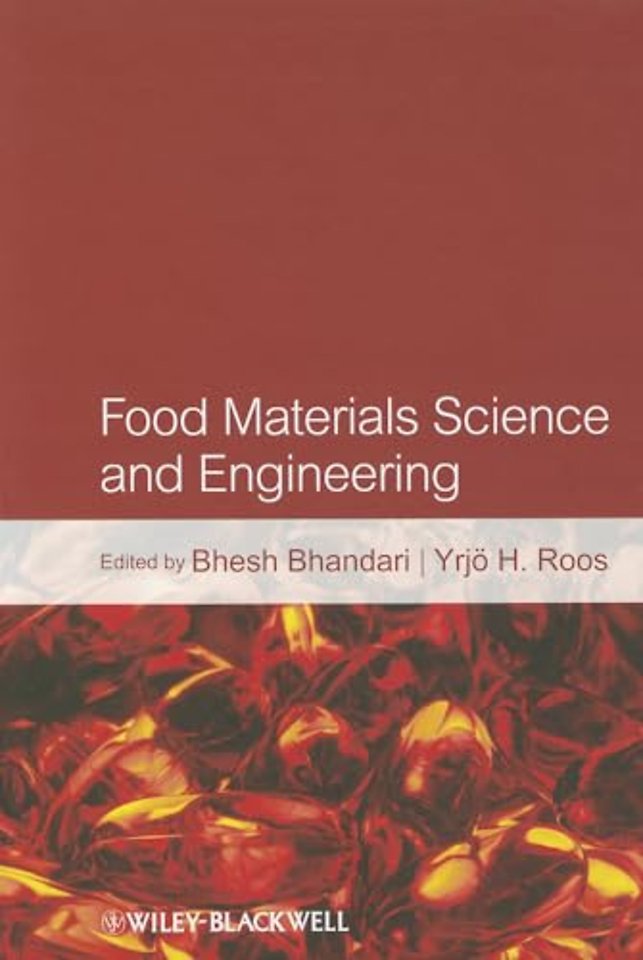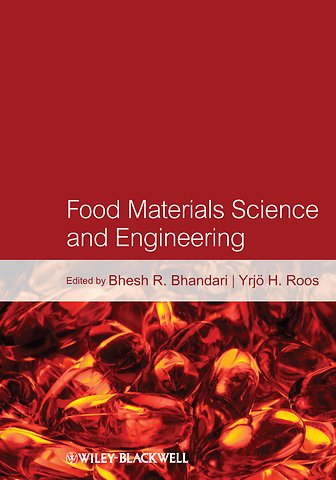Food Materials Science and Engineering
Samenvatting
Food Materials Science and Engineering covers a comprehensive range of topics in relation to food materials, their properties and characterisation techniques, thus offering a new approach to understanding food production and quality control.
The opening chapter will define the scope and application of food materials science, explaining the relationship between raw material structure and processing and quality in the final product. Subsequent chapters will examine the structure of food materials and how they relate to quality, sensory perception, processing attributes and nutrient delivery. The authors also address applications of nanotechnology to food and packaging science. Methods of manufacturing food systems with improved shelf–life and quality attributes will be highlighted in the book.
Specificaties
Inhoudsopgave
<p>List of Contributors xi</p>
<p>1 Food Materials Science and Engineering: An Overview 1<br /> Bhesh Bhandari and Yrjö H. Roos</p>
<p>1.1 Introduction 1</p>
<p>1.2 Molecular basis of food materials 4</p>
<p>1.3 Observation of materials at various size ranges and size–property</p>
<p>relationship 5</p>
<p>1.4 Amorphous and crystalline structures of materials 7</p>
<p>1.5 Gel structures of food materials 10</p>
<p>1.6 Interfacial properties of the food materials 14</p>
<p>1.7 Application of materials science in food design and development</p>
<p>of engineered food materials 21</p>
<p>1.8 Conclusion 23</p>
<p>References 23</p>
<p>2 Micro to Macro Level Structures of Food Materials 26<br /> Deepak Bhopatkar, Bruce R. Hamaker and Osvaldo H. Campanella</p>
<p>2.1 Microstructure definitions 26</p>
<p>2.2 Measurement of microstructures/nanostructures 28</p>
<p>2.3 The relationship between structure and quality 31</p>
<p>2.4 Microstructure and emulsions 35</p>
<p>2.5 Structure and sensory perception 37</p>
<p>2.6 Process to control the structure of food materials 39</p>
<p>2.7 Concluding remarks 45</p>
<p>References 45</p>
<p>3 Characterisation Techniques in Food Materials Science 52<br /> Elliot Paul Gilbert, Amparo Lopez–Rubio and Michael J. Gidley</p>
<p>3.1 Introduction 52</p>
<p>3.2 Nuclear Magnetic Resonance (NMR) 53</p>
<p>3.3 Fourier Transform Infra–Red (FT–IR) 59</p>
<p>3.4 X–ray powder diffraction 64</p>
<p>3.5 Small angle neutron & X–ray scattering (SANS and SAXS) 68</p>
<p>3.6 Confocal microscopy 78</p>
<p>3.7 Scanning electron microscopy 81</p>
<p>3.8 Atomic Force Microscopy (AFM) 84</p>
<p>3.9 Summary 87</p>
<p>References 87</p>
<p>4 Interfacial Phenomena in Structured Foods 94<br /> Matt Golding</p>
<p>4.1 Introduction 94</p>
<p>4.2 Visualisation of surface structures 95</p>
<p>4.3 Fundamentals of interfacial assembly 102</p>
<p>4.4 The dynamic interface 108</p>
<p>4.5 Conclusions and future directions 130</p>
<p>References 131</p>
<p>5 Phase and State Transitions and Related Phenomena in Foods 136<br /> Yrjö H. Roos</p>
<p>5.1 Introduction 136</p>
<p>5.2 Phase and state transitions 137</p>
<p>5.3 Food properties and formulation 144</p>
<p>5.4 Conclusions 148</p>
<p>References 149</p>
<p>6 Food Biopolymer Gels, Microgel and Nanogel Structures, Formation and Rheology 151<br /> Jason R. Stokes</p>
<p>6.1 Introduction 151</p>
<p>6.2 Rheology of food gels: yielding and gelling soft matter 152</p>
<p>6.3 Formation and structure of biopolymer network gels 153</p>
<p>6.4 Formation and structure of micro– and nano–gel particles 159</p>
<p>6.5 Structure rheology relationships of food gels and food gel structures 165</p>
<p>6.6 Outlook 171</p>
<p>Acknowledgements 172</p>
<p>References 172</p>
<p>7 Materials Science Approaches Towards Food Design 177<br /> Job Ubbink</p>
<p>7.1 Introduction 177</p>
<p>7.2 Consumer–driven food design 177</p>
<p>7.3 Food design based on the supplemented state diagram 179</p>
<p>7.4 Design of foods and encapsulation systems in the glassy state 191</p>
<p>7.5 Retro–design for the delivery of bioactive ingredients in foods 195</p>
<p>7.6 Concluding remarks 201</p>
<p>References 202</p>
<p>8 Food Structures and Delivery of Nutrients 204<br /> Ranjan Sharma</p>
<p>8.1 Introduction 204</p>
<p>8.2 Nutrient digestion and absorption in the gastrointestinal tract 205</p>
<p>8.3 Nutrients and their delivery challenges 208</p>
<p>8.4 Essential fatty acids 209</p>
<p>8.5 Antioxidants including vitamins and minerals 209</p>
<p>8.6 Probiotic bacteria 211</p>
<p>8.7 Plant sterols 211</p>
<p>8.8 Food structures and technologies for protection and delivery</p>
<p>of nutrients 212</p>
<p>8.9 Protein–based structures for nutrient delivery 212</p>
<p>8.10 Microencapsulation 214</p>
<p>8.11 Fluidised bed coating 214</p>
<p>8.12 Spray drying 215</p>
<p>8.13 Spray chilling 215</p>
<p>8.14 Extrusion 216</p>
<p>8.15 Nanoparticles and emulsions 216</p>
<p>8.16 Food structure and bio–accessibility of nutrients 217</p>
<p>8.17 Conclusions and future directions 218</p>
<p>References 218</p>
<p>9 Effects of Emerging Processing Technologies on Food Material Properties 222<br /> Henry Jaeger, Kai Reineke, Katharina Schoessler and Dietrich Knorr</p>
<p>9.1 Introduction 222</p>
<p>9.2 Pulsed electric fields (PEF) effect on food material properties 223</p>
<p>9.3 Isostatic high pressure (HP) effects on food material properties 237</p>
<p>9.4 Ultrasound (US) effect on food material properties 247</p>
<p>9.5 Conclusion and future trends 253</p>
<p>References 254</p>
<p>10 Food Protein Nanoparticles: Formation, Properties and Applications 263<br /> Simon M. Loveday, M. A. Rao and Harjinder Singh</p>
<p>10.1 Introduction 263</p>
<p>10.2 Characterising the rheological properties of gels and dispersions 264</p>
<p>10.3 Formation and functionality of whey protein nanoparticles 265</p>
<p>10.4 Nanofibrils from food proteins 269</p>
<p>10.5 Protein polysaccharide complexes 285</p>
<p>10.6 Concluding remarks 287</p>
<p>Notation 288</p>
<p>References 289</p>
<p>11 Nanocomposites for Food and Beverage Packaging Materials 295<br /> Maria D. Sanchez Garcia and Jose M. Lagaron</p>
<p>11.1 Introduction 295</p>
<p>11.2 Barrier properties in packaging 298</p>
<p>11.3 Nanofillers for nanocomposite packaging materials 305</p>
<p>11.4 Examples of nanocomposites and their properties 309</p>
<p>11.5 Nanobiocomposites: concepts and barrier properties 311</p>
<p>11.6 Future trends 315</p>
<p>References 315</p>
<p>12 Encapsulation Techniques for Food Ingredient Systems 320<br /> Zhongxiang Fang and Bhesh Bhandari</p>
<p>12.1 Introduction 320</p>
<p>12.2 Microencapsulation techniques 323</p>
<p>12.3 Conclusion 343</p>
<p>References 344</p>
<p>13 Food Texture is Only Partly Rheology 349<br /> Olena Kravchuk, Peter Torley and Jason R. Stokes</p>
<p>13.1 Introduction 349</p>
<p>13.2 Texture is a multi–parameter sensory property 350</p>
<p>13.3 Texture research is driven by consumer food acceptance 351</p>
<p>13.4 Current directions in texture research 352</p>
<p>13.5 Texture receptors 354</p>
<p>13.6 Oral processing 355</p>
<p>13.7 Role of saliva in sensory texture 357</p>
<p>13.8 Instrumental methods for texture quantification 359</p>
<p>13.9 Sensory evaluations of texture 362</p>
<p>13.10 Statistical methods in texture studies 365</p>
<p>13.11 Summary 368</p>
<p>References 369</p>
<p>14 Materials Science of Freezing and Frozen Foods 373<br /> Yrjö H. Roos</p>
<p>14.1 Introduction 373</p>
<p>14.2 Freezing of simple solutions 374</p>
<p>14.3 Nucleation and crystal growth 375</p>
<p>14.4 Materials science aspects of nucleation in food freezing 377</p>
<p>14.5 Time–dependent ice formation 380</p>
<p>14.6 Manipulation of nucleation and crystal size 381</p>
<p>14.7 Recrystallisation in frozen foods 382</p>
<p>14.8 Conclusions 384</p>
<p>References 385</p>
<p>Index 387</p>
Net verschenen
Rubrieken
- aanbestedingsrecht
- aansprakelijkheids- en verzekeringsrecht
- accountancy
- algemeen juridisch
- arbeidsrecht
- bank- en effectenrecht
- bestuursrecht
- bouwrecht
- burgerlijk recht en procesrecht
- europees-internationaal recht
- fiscaal recht
- gezondheidsrecht
- insolventierecht
- intellectuele eigendom en ict-recht
- management
- mens en maatschappij
- milieu- en omgevingsrecht
- notarieel recht
- ondernemingsrecht
- pensioenrecht
- personen- en familierecht
- sociale zekerheidsrecht
- staatsrecht
- strafrecht en criminologie
- vastgoed- en huurrecht
- vreemdelingenrecht

